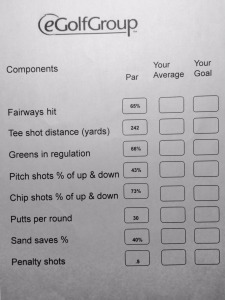Golf Fitness
For those of you who want to narrow the gap between practice and play there are cardinal rules for golf practice that will get you from there to here.
Virtually everyone who has played the game has encountered the Dr. Jekyll/Mr. Hyde experience when it comes to the performance on the practice tee versus the golf course. On the range, you can flawlessly send ball after ball flying toward the target; then you head out to the course and see your mastery evaporate.
When this happens, golfers tend to react in one of two ways. Some avoid practice altogether; since it doesn’t seem to help their game, “why bother?” Others think “If I just hit more balls….” it will pay off on the course. Unfortunately, neither approach will work. Instead, your practice must support your specific performance goals on the course.
CARDINAL RULES FOR PRACTICE
Warm-up; don’t practice before a round. Warm-up is 15-25 balls total, 5-10 each of full and short swings. You are just loosening up. You’ve probably seen the following scenario: a golfer arrives at the course early and heads to the practice tee. During practice the wheels fall off; they panic and try harder, which only makes matters worse. The golfer arrives at the first tee sweating, out of breath and with a bad attitude. You know they will have a bad round. The reverse is also possible: The golfer goes to the range before tee-time and hits fantastic shots; they head to the tee full of confidence (and unrealistic expectations) for the round. So when the expectations aren’t met, their game unravels on the course…. Sound familiar?
Know when to stop. When you practice, quality is definitely more important than quantity. Don’t feel compelled to “finish the pyramid” before you leave the range. Sure, it’s hard to stop when you have just hit a perfect shot, but regardless of the reason, don’t hit more than you need. Fatigue and loss of concentration are two indicators that a session is too long. To control fatigue, try not to hit more than 10 balls without a “mini-break”. Take your hands off the club and collect your thoughts. Switch frequently between different clubs and shot techniques to keep your concentration fresh.
Don’t neglect the trouble shots. The purpose of practice is to avoid trouble on the golf course. However, on that odd occasion where you find yourself in a tough spot, the proper technique will allow you to escape with the least amount of damage to your score. Create trouble situations on the practice range such as shots out of the rough or off the hard pan. Uneven lies and fairway bunker shots are other example.
Why Practice?
Before you begin your practice session try to determine what you want to accomplish. Be specific as to why you practice. This is a prime element in your ability to “self coach” as you improve your game. There are four major reasons to practice:
Curative: sessions that address some specific problem
(ex. get rid of a slice)
Developmental: sessions that integrate new techniques
(ex. a lob shot in pitching)
Maintenance: sessions used to maintain your current skill level
(ex. a P.A.R. System PRACTICE GUIDE session)
Strategic: sessions to modify technique to fit certain conditions
(ex. play under windy conditions)
WHAT TO PRACTICE
After you identify “why to practice” move on to “what to practice”. Focus your practice session on the parts of your game where your performance does not meet your goals. For instance, if your chip shot percentage “up & down” is under your goal, then allocate practice time for chip shot accuracy. What would it do to your scores if you could improve your chip shot percentage by 20 percent?
There are several ways to determine your goals; you can refer to your P.A.R. System GOLF ROUND ANALYSIS performance assessment (a sample is at the end of this booklet), work with your golf professional, or you may just “know” your goals.
When you follow your scores in a P.A.R. System GOLF ROUND ANALYSIS booklet you will stay in touch with your goals.
There are a number of different ways to practice, and as is the case in almost any endeavor, you get out what you put in. Remember, practice is undertaken on the premise that it will improve your performance and enjoyment under playing conditions. It may sound like practice isn’t fun, but it doesn’t have to be that way! Go out and hit balls just for the fun of it; just to be careful not to get judgmental or upset if you hit a bad one . After all, when there isn’t a specific objective for a session, anything could happen. Most of the time, you should use your PRACTICE GUIDE to keep your practice sessions performance related and focused on your goal.
P.A.R. System GOLF ROUND ANALYSIS
Dave Bisbee, Director of Golf Operations, Seven Canyons-Sedona
Founder E-Golf Group

